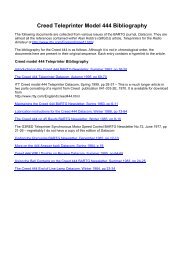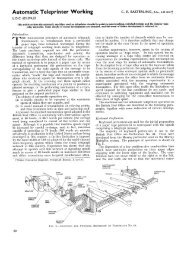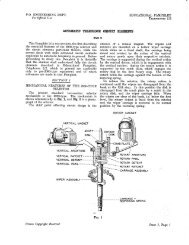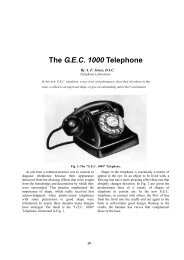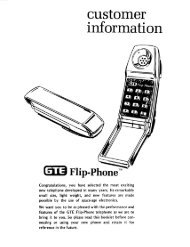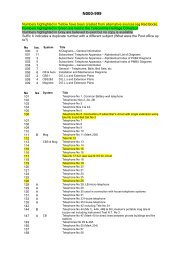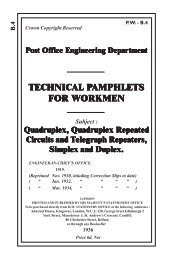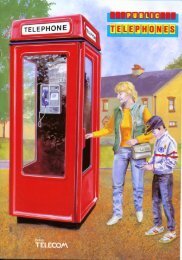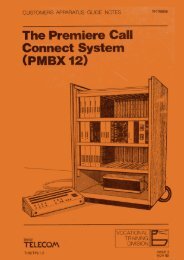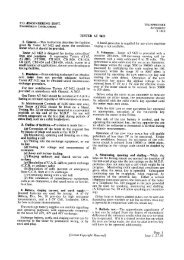TRAFFIC CONTROL TELEPHONE SYSTEMS Circuit - Sam Hallas
TRAFFIC CONTROL TELEPHONE SYSTEMS Circuit - Sam Hallas
TRAFFIC CONTROL TELEPHONE SYSTEMS Circuit - Sam Hallas
Create successful ePaper yourself
Turn your PDF publications into a flip-book with our unique Google optimized e-Paper software.
Cycle of Events on Receiving a Code<br />
Taking the same code as used in the description of the 4001-A Selector Key,<br />
viz.: 3-11-3, the sequence of events is as follows :<br />
On operating the selector key the battery relay of the system is operated,<br />
connecting the line battery to the line, and remaining operated during the complete<br />
revolution of the key. The initial operation of the battery relay sends an isolated<br />
impulse (not included in the 17 coding impulses) which energises all selectors on the<br />
line giving a flick to the holding spring, thereby releasing any selector which might<br />
have been held on a coding pin. The first-set of impulses from the calling key are<br />
reproduced by the impulsing relay which gives three impulses of alternating polarity<br />
to the line. These three impulses advance all the selectors three steps. Then, although<br />
the battery is held on the line the condenser in series with each selector (see Fig. 1)<br />
stops the flow of current and the armatures of all selectors release. The code wheels<br />
of all selectors, then return to normal except those coded with three as the first digit,<br />
these are held in position by the holding spring K (Fig. 10). All selectors are then<br />
advanced by the second set of impulses, 11 in this case.<br />
Of the selectors that were held in an advanced position before, only the one<br />
called will now have a code pin in the second pin position to be engaged by the<br />
holding spring, because there would be only one station on the line with the first digit<br />
of three and second digit of eleven. The selectors that returned to normal after the first<br />
digit and which have a first digit of 11 will be in position to be held by the holding<br />
spring. All other selector code wheels will restore to normal during the pause of<br />
approximately one second after the second digit.<br />
A total of 14 impulses have now been received and the selector under consideration<br />
is therefore held at the 14th step. The third set of impulses, three in number,<br />
advances all selectors three steps.<br />
Only the selector that had its code pins in the code wheel set for 3-11-3 (the<br />
selector called) will have reached the permanent code pin or ringing position, that is,<br />
a total of 17 steps from the normal position. In this position the contact spring on the<br />
top of the code wheel will be directly over the first ringing terminal and making<br />
contact with it. Some of the selectors may be held on the first code pin, but will not<br />
have advanced to the third or ringing code pin. It will be seen therefore that all<br />
selectors respond to the impulsing but only the one coded to correspond with the<br />
code transmitted reaches the ringing position. During the ringing period of approximately<br />
two seconds, a ring-back tone is heard by the Controller or other receiver<br />
across the line while the call bell is ringing.<br />
Referring to Fig. 1, the ring-back circuit is as follows: L1, .02 μF capacitor<br />
through the selector contacts, ringing battery, bell contacts, .02 μF capacitor, L2,<br />
controller's telephone and back to L1.<br />
Page 27



